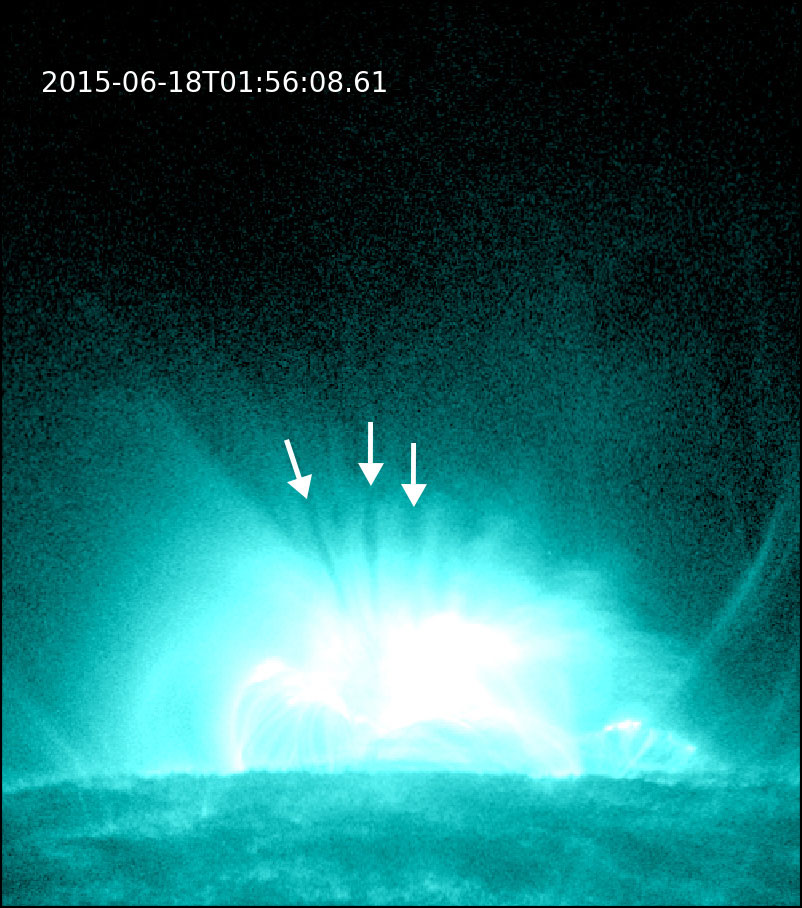

Solar flares are complex phenomena. They involve plasma, electromagnetic radiation across all wavelengths, activity in the Sun’s atmosphere layers, and particles travelling at near light speed. Spacecraft like NASA’s Solar and Heliophysics Observatory (SOHO) and the Parker Solar Probe shed new light on the Sun’s solar flares.
But it was a Japanese-led mission called Yohkoh that spotted an unusual solar flare in 1999. This flare displayed a downward flowing motion toward the Sun along with the normal outward flow. What caused it?
A team of researchers think they’ve figured it out.
When the 1999 Yuhkoh flare was spotted, astrophysicists wondered what caused the downward motion. They called these dark finger-like phenomena “downward-moving dark voids.” Astrophysicists have a more accurate term for them now: supra-arcade downflows (SADs.)
A group of researchers led by Chengcai Shen have an explanation for SADs. Shen is an astronomer at the CfA, the Harvard and Smithsonian Center for Astrophysics. The team’s paper is “The origin of underdense plasma downflows associated with magnetic reconnection in solar flares.” The journal Nature Astronomy published the work.
A solar arcade is an active area with multiple coronal loops. Coronal loops are magnetic structures that extend from the Sun’s photosphere out into the corona, looping back down to reconnect with the photosphere again. Coronal loops trap plasma magnetically, and that makes them visible.
A supra-arcade is a solar arcade with added features. Along with the loops, there are downflows above the arcade. Scientists thought supra-arcades are somehow connected with the magnetic reconnection behind solar flares, but the specifics were unknown.
“We wanted to know how these structures occur,” says lead author and CfA astronomer Chengcai Shen. “What’s driving them, and are they truly tied to magnetic reconnection?”
The Sun has complex magnetic fields that can become compressed and disfigured. They can break, releasing fast-moving and powerful radiation along magnetic lines, then reconnect to form loops.
“On the Sun, what happens is you have a lot of magnetic fields that are pointing in all different directions. Eventually, the magnetic fields are pushed together to the point where they reconfigure and release a lot of energy in the form of a solar flare,” says study co-author and CfA astronomer Kathy Reeves.
“It’s like stretching out a rubber band and snipping it in the middle. It’s stressed and stretched thin, so it’s going to snap back,” Reeves added.
That knowledge is firmly established, so it’s reasonable to conclude that the same mechanism guided SADs. “A characteristic feature of magnetic reconnection is the production of fast reconnection outflow jets near the plasma Alfven speeds,” the authors write in their paper. “In eruptive solar flares, dark, finger-shaped plasma
downflows moving toward the flare arcade have been commonly regarded as the principal
observational evidence for such reconnection-driven outflows.”
But observations didn’t entirely back that explanation. It comes down to speed.
“However, they often show a speed much slower than that expected in reconnection theories, challenging the reconnection-driven energy release scenario in standard flare models,” they write.
In the elastic band analogy, the snap-back is rapid. But when scientists watched these SADs, most of them didn’t snap back. Instead, they reconnected more slowly with the Sun. If the same thing happened with an elastic band, we’d think somebody spiked our drink.
“This is not predicted by classic reconnection models, which show the downflows should be much quicker. It’s a conflict that requires some other explanation,” lead author Shen said.
Here’s where NASA’s Solar Dynamics Observatory (SDO) comes in. NASA launched the SDO in 2010 to study the nature of the Sun-Earth system and how it affects life on Earth. One of the SDO’s instruments is the Atmospheric Imaging Assembly (AIA.) The AIA gives us continuous full-disk coverage of the Sun’s chromosphere and corona.
Shen and the other authors created 3D simulations of solar flares and compared them to solar flares the SDO observed. They found that magnetic reconnection isn’t the source of SADs.
Instead, fluid dynamics are at the heart of SADs. Two fluids of different densities create the SADs when they interact in the turbulent environment above the arcade.
The authors say that the turbulent environment in this “interface region” where downward reconnection outflows impinge on closed flare arcades hasn’t received much attention in previous research. “This interface region hosts a myriad of turbulent flows, electron currents, and shocks, crucial for flare energy release and particle acceleration,” the authors explain in their paper. They liken it to another astrophysical phenomenon, “… the highly turbulent region sandwiched between the forward and reverse shock in supernova remnants,” they write. Plasma in that region of a supernova also forms finger-like structures.
In this case, the two fluids are both plasmas. But they have different densities, leading to the unexplained behaviour of SADs.
“Those dark, finger-like voids are actually an absence of plasma. The density is much lower there than the surrounding plasma,” co-author Reeves explained.
The authors intend to keep studying SADs and other solar features using observations and simulations. They think their work might lead to better tools for predicting space weather.
NASA continues to progress with the development of the Nancy Grace Roman Space Telescope (RST),…
Our neighbour, the Large Magellanic Cloud (LMC), is rich in gas and dust and hosts…
New research on locomotion techniques that could be used in space exploration is constantly coming…
White dwarfs are the remnants of once brilliant main sequence stars like our Sun. They're…
We all know that asteroids are out there, that some of them come dangerously close…
It’s a familiar sight to see astronauts on board ISS on exercise equipment to minimise…